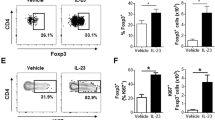Abstract
The presence of T regulatory cells (Tregs) is highly required in normal skin in order to maintain immune tolerance to commensal microbes and to prevent the development of immune-mediated inflammation. Psoriasis is a chronic inflammatory skin disease in which effector T cells, namely, Th17 and their relevant pro-inflammatory cytokines are increased in peripheral blood as well as in the inflamed skin. The status of Tregs in psoriatic skin is continuously studied. In this case, CD4 + CD25high T cells and other regulatory cytokines such as IL-35 are demonstrated to be significantly decreased. Aiming to better characterize Tregs in psoriatic skin and to establish the finding of their abnormal balance, we assessed the expression of semaphorin3A and neuropilin-1 (both reported as biomarkers of Tregs). Semaphorin3A and neuropilin-1 expressing Tregs were found to be significantly decreased in psoriatic skin when compared to normal skin. These findings were supported by demonstrating the downregulation of IL-10 expression in psoriatic skin. Our findings suggest that semaphoring3A may turn to be a new promising therapeutic approach in the process of improving Treg function in psoriasis.




Similar content being viewed by others
References
Gisondi P, Di Mercurio M, Idolazzi L, Girolomoni G. Concept of remission in chronic plaque psoriasis. J Rheumatol Suppl. 2015;93:57–60.
Ghoreschi K, Weigert C, Rocken M. Immunopathogenesis and role of T cells in psoriasis. Clin Dermatol. 2007;25:574–80.
Ayala-Fontanez N, Soler DC, McCormick TS. Current knowledge on psoriasis and autoimmune diseases. Psoriasis (Auckl). 2016;6:7–32.
Ortega C, Fernandez-A S, Carrillo JM, Romero P, Molina IJ, Moreno JC, et al. IL-17-producing CD8+ T lymphocytes from psoriasis skin plaques are cytotoxic effector cells that secrete Th17-related cytokines. J Leukoc Biol. 2009;86:435–43.
Res PC, Piskin G, de Boer OJ, van der Loos CM, Teeling P, Bos JD, et al. Overrepresentation of IL-17A and IL-22 producing CD8 T cells in lesional skin suggests their involvement in the pathogenesis of psoriasis. PLoS One. 2010;5:e14108.
Teunissen MBM, Yeremenko NG, Baeten DLP, Chielie S, Spuls PI, de Rie MA, et al. The IL-17A-producing CD8+ T-cell population in psoriatic lesional skin comprises mucosa-associated invariant T cells and conventional cells. J Invest Dermatol. 2014;134:2898–7.
Zaba LC, Fuentes-Duculan J, Eungdamrong NJ, Abello MV, Novitskaya I, Pierson KC, et al. Psoriasis is characterized by accumulation of immunostimulatory and Th1/Th17 cell-polarizing myeloid dendritic cells. J Invest Dermatol. 2009;129:79–88.
Diani M, Altomare G, Reali E. T cell responses in psoriasis and psoriatic arthritis. Autoimmun Rev. 2015;14:286–92.
Luan L, Ding Y, Han S, Zhang Z, Liu X. An increased proportion of circulating Th22 and Tc22 cells in psoriasis. Cell Immunol. 2014;290:196–200.
Zhang L, Li Y, Yang X, Wei J, Zhou S, Zhao Z, et al. Charaterization of Th17 and FoxP3+ Treg cells in pediatric psoriasis patients. Scand J Immunol. 2016;83:174–80.
Bovenschen HJ, van de Kerkhof PC, van Erp PE, Woestenenk R, Joosten I, Koenen HJ. FoxP3+ regulatory T cells of psoriasis patients easily differentiate into IL-17A-producing cells and are found in lesional skin. J Invest Dermatol. 2011;131:1853–60.
Yang L, Li B, Dang E, Jin L, Fan X, Wang G. Impaired function of regulatory T cells in patients with psoriasis is mediated by phosphorylation of STAT3. J Dermatol Sci. 2016;81:85–92.
Gatzka M. Skin under Thf influence: how regulatory T cells work against macrophages in psoriasis. J Pathol. 2017;241:3–5.
Sanchez Rodrigues R, Pauli ML, Neuhaus IM, Yu SS, Arron ST, Harris HW, et al. Memory regulatory T cells reside in human skin. J Clin Invest. 2014;124:1027–36.
Wang RX, Yu CR, Dambuza IM, Mahdi RM, Dolinska MB, Sergeev YV, et al. Interleukin-35 induces regulatory B cells that suppress autoimmune disease. Nat Med. 2014;20:633–41.
Vadasz Z, Toubi E. Semaphorins: their dual role in regulating immune-mediated diseases. Clin Rev Allergy Immunol. 2014;47:17–25.
Catalano A. The neuroimmune semaphoring-3A reduces inflammation and progression of experimental autoimmune arthritis. J Immunol. 2010;185:6373–83.
Vadasz Z, Rainis T, Nakhleh A, Hai T, Bejar J, Halasz K, et al. The involvement of immune semaphorins in the pathogenesis of inflammatory bowel diseases. PLoS One. 2015;10:e0125860.
Vadasz Z|, Toubi E. Semaphorin 3A- a marker for disease activity and a potential putative disease-modifying treatment in systemic lupus erythematosus. Lupus 2012; 21: 1266–1270.
Bejar J, Kessler O, Sabag AD, Sabo E, Itzhak OB, Neufeld G, et al. Semaphorin3A: a potential therapeutic tool for lupus nephritis. Front Immunol. 2018;9:634. https://doi.org/10.3389/fimmu.2018.00634.
Tominaga M, Takamori K. Itch and nerve fibers with special references to atopic dermatitis: therapeutic implications. J Dermatol. 2014;41:205–12.
Ali N, Rosenblum MD. Regulatory T cells in skin. Immunology. 2017;152:372–81.
Kotb IS, Lewis BJ, Barker RN, Ormerod AD. Differential effects of phototherapy, adalimumab and betamethasone-calcipotriol on effector and regulatory T cells in psoriasis. Br J Dermatol. 2018;179:127–35. https://doi.org/10.1111/bjd.16336.
Author information
Authors and Affiliations
Corresponding author
Ethics declarations
Conflict of Interests
All authors declair that they do not have any conflict of interest regarding this manuscript.
Additional information
Publisher’s note
Springer Nature remains neutral with regard to jurisdictional claims in published maps and institutional affiliations.
Rights and permissions
About this article
Cite this article
Sabag, A.D., Dias-Polak, D., Bejar, J. et al. Altered expression of regulatory molecules in the skin of psoriasis. Immunol Res 66, 649–654 (2018). https://doi.org/10.1007/s12026-018-9057-9
Published:
Issue Date:
DOI: https://doi.org/10.1007/s12026-018-9057-9




